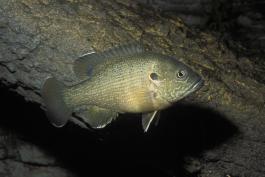
The green sunfish is thick-bodied, with a large mouth, the upper jaw extending to about the middle of the eye. Back and sides are bluish green, grading to pale yellow or white on the belly. Black vertical bars are sometimes evident on the sides. Blue mottlings and streaks are present on the side of the head. Pelvic fins in breeding males are white or pink, and the tail and anal and dorsal fins are tipped with white or salmon-pink. Usually has a dark splotch on back of dorsal fin. Long, dark ear flap. Rounded pectoral fin.
Total length: 6 to 8 inches; maximum about 10 inches and 1 pound.

Statewide.
Habitat and Conservation
Green sunfish can be found in any pond, lake, or stream that is capable of supporting fish life. They are often found in pools and backwaters of streams that become isolated and stagnant during the summer or drought. They are most active throughout daylight hours. They are most closely related to bluegill, redear, and other sunfishes.
Food
Carnivorous, feeding on insects, crayfish, and small fish.
Status
A nongame fish.
Life Cycle
Green sunfish begin spawning in mid to late May, when water temperatures rise over 70 F. Spawning activity peaks in June, and it can continue into August. Individuals can live for 6 years.
Human Connections
This panfish is available to anglers statewide. Provides fishing opportunities in small, intermittent creeks, where other hook-and-line fish cannot live. Still-fishing with a cane pole and bobber, using worms, grubs, or grasshoppers as bait, is about as effective as any method for catching them.
Ecosystem Connections
Green sunfish may be the largest fish in some of the small streams where it occurs, making it a top predator in the aquatic ecosystem. As with all fish, however, they start out small, and many sunfish eggs and juveniles are eaten by a variety of predators. Herons, watersnakes, and other vertebrates also feed on sunfish.









































